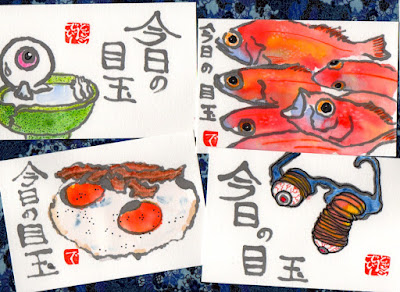 | |
| Tomato etegami by my good friend Youko Ogawa |
It has often been observed that people who take up the art of Etegami after having mastered other forms of visual arts have a harder time producing orthodox etegami than the absolute beginner. And though one of the characteristics of Etegami is said to be its lack of rules (compared to other traditional Japanese arts), it sure doesn't seem that way to the western artist. One of the "not-a-rule-but-still..." traditions of orthodox etegami is the blank background.
Take a look at the works posted on the Japan Etegami Society website. If the page appears correctly on your screen, you will see links (near the bottom of the page) to the month-by-month archives of etegami selected from among the many submitted by JES members every year. A few of these submissions are elegantly rendered in the style of sumi-e, but the majority are somewhat awkward representations of their subjects-- in other words, Etegami at its Best! None of the images have shadows. The background is blank in every one.
The second photo I posted above is a page from the September 2012 issue of Gekkan Etegami (the Japanese Etegami Society's official magazine) which gives samples of what the JES considers exemplary etegami. Most of them are awkwardly charming, and none have any background shadows. By coincidence, I had hosted a global etegami call on the subject of tomatoes just two years earlier, in 2010. After the online exhibit came to an end, I showed the works to the members of the Etegami group I meet with every month. Like me, these Japanese ladies have been painting etegami for decades, and I wondered how they would respond to these submissions. Their comments were revealing.
While they were genuinely delighted with the artwork, and even more thrilled that interest in etegami had started spreading beyond the borders of Japan, they struggled with the question of whether the works qualified as etegami at all. "As beautiful as it is, the shadow on this one disqualifies it from being etegami," said the most experienced member of our group, pointing at the purple shadowing underneath a tomato. "It's a still life painting rather than an etegami."
They had some other intriguing responses as well. Please read the complete comments at this blog post and share your thoughts with me.































